Pirate Bikes in the Wilhelmina Cullen Admissions Center:
Recontextualizing and Making Meaning
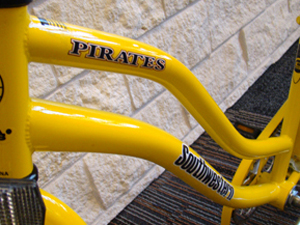
Pirate Bikes in the Wilhelmina Cullen Admissions Center:
Recontextualizing and Making Meaning

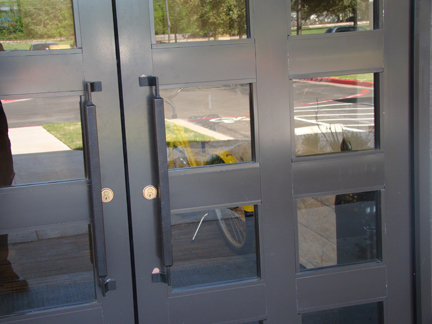
| 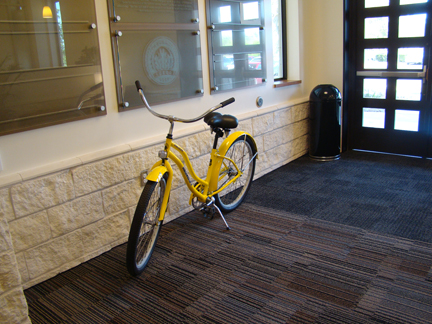
you can see the bike through the door.
| |
On this page, I will briefly explore the general function of Pirate Bikes at Southwestern. Then, I will delve into the numerous ways Pirate Bikes are mobilized inside the WCAC and how they function in that context. More important then the bikes themselves, I will analyze how the WCAC utilizes Pirate Bikes to perform Southwestern.
Since Pirate Bikes were introduced to Southwestern in 2005, they've become a trademark of SU. Pirate Bikes are Southwestern's system of community bicycles and share many characteristics of Austin's Yellow Bike program. They're free, always unlocked, and available to any student, faculty, or staff member to hop on and take anywhere on campus.
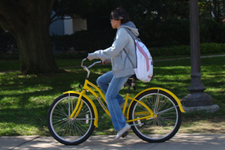
| The bikes are bright yellow. They all have "Southwestern" and "Pirates" written in black across the sides. They favor simplicity and durability over features like gears or handbrakes. There are two types of Pirate Bikes that, on-campus, are known as male and female types. The male types have an oblong, football shaped body, while the female types have a low curve to them and ride a little lower. Being in constant use, every Pirate Bike has a unique amount of wear, ranging from missing kickstands to flat tires and broken chains. |
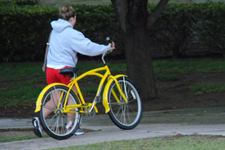
|
|
| |
The female-type Pirate Bike stationed inside the WCAC is different though. First, it is completely undamaged, although this isn't a big difference. The bigger differences are that the bike is parked inside, has a sticker on the seat that reads "admission office," lacks an identifying number, and has zip ties that immobilize the back tire. These features add up to a clear indication that this bike is not intended to be ridden. Rather, it is there specifically as a static showpiece.
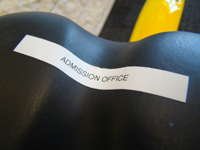
|
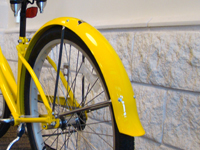
|
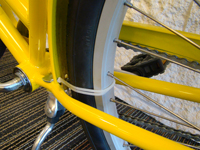
|
As I mention in the introduction, the WCAC's purpose is to perform Southwestern to visitors. This Pirate Bike is an important actor in this performance. Out in the wild, however, the Pirate Bikes already give a performance of SU. When students use and share the bikes around campus, they're engaging in a performance that shows Southwestern as a tight-knit community. It is a performance that is ongoing and continually reinforces this idea of Southwestern, both to the campus community and to visitors. Also, while seeing the Pirate Bikes in action is part of the performance, a much more important part is the experience of engaging in and being complicit in the performance.
This problematizes the performance created by the placement of the Pirate Bike in the WCAC. Their audience is, for the large part, prospective students and parents. First, prospective students and parents cannot ride Pirate Bikes. Since they are usually only brief visitors to Southwestern, there is little opportunity for them to see them in action either.
In Rose's (2006) chapter on visual objects, there is a focus on "what happens when something is done with visual materials" (p. 217), and how "mobilizing" visual materials, or moving them into a different context, can shift their meanings. Ironically, this bike's mobility comes from being immobilized. What they have "done" to the bike is make it so that no one can physically do anything to it. Pirate Bikes' usual context is being outside and communally shared. This bike is only for show.
In semiotic terms, it serves a both iconic and an indexical function in its relationship to the other bikes. Even though it is disabled, it is an icon because it visually and physically resembles the other bikes. This bike clearly denotes that there are other un-tethered versions available on-campus and as such is indexical.
Hattenhauer (1984) gets at the idea that "the symbolic meaning is sometimes more important than the actual use" (p. 73). An example that Hattenhauer (1984) uses in his article "The Rhetoric of Architecture: A Semiotic Approach" is the retaining fence in courtrooms. Their original function, providing a physical barrier, has been lost. They continue to exist in courtrooms, but are not built to physically restrain anyone. Rather, they are a signifier for 'courtroom' and "underscore that the room is a courtroom and one should behave accordingly" (p. 73). The WCAC has done a similar thing with this Pirate Bike. Because it has been moved indoors and immobilized, the bike has lost its original function - transportation. The "admission office" Pirate Bike, then, must serve as a signifier for the outdoor, usable bikes.
Still, this bike fits into the WCAC's postmodern sensibilities. As I mentioned in the introduction, the WCAC references or "cites" other architectural styles in its pursuit of symbolic meaning. Similarly, the symbolic WCAC Pirate Bike references the authentic, everyday usable bike. It references Pirate Bikes in the same way it does other cultural concepts, using them for their rhetorical value rather than functional. An idea in Rose's (2006) chapter on visual objects is that "when things travel, the meanings and values that attach to objects become particularly evident" (p. 223). I find that this is the case with Pirate Bikes. The "admission office" Pirate Bike is barred from the everyday performance of the outdoor bikes. By referencing that performance, however, they make the "meanings and values" (p. 223) of a progressive and tight-knit community explicit.
|
Pirate Bikes are found in other parts of the WCAC as well.
Across the main lobby, there is a rack full of informational pamphlets on Southwestern.
On two different pamphlets, this photograph is reproduced on the cover.
This image, being much more abstract, carries a deeper range of meanings. Notice the way that the Pirate Bike is foregrounded in this image, and, perhaps more importantly, how the Cullen tower is unfocused and backgrounded. Cullen is Southwestern's oldest building and the Cullen tower is an iconic image of SU. In this image, the communal bike represents Southwestern's more liberal, progressive values. Cullen, on the other hand, represents SU's traditional, historical values. |
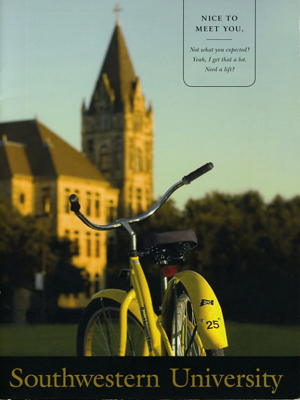
|
This is a much bigger recontextualiztion of the Pirate Bike. The pamphlet-bikes are being used as a signifier for a higher-level meaning through its direct relationship with another signifier, the Cullen tower. The meaning being created is based on the direct juxtaposition of the Pirate Bike and the Cullen tower. As Rose (2006) states, "it is what is done with things that produces their significance," rather then some "inherent meaning" (p. 220). The play between the Pirate Bike and the Cullen Tower is representative of a much larger theme found in the building, a play between traditional and progressive values. Pirate Bikes are used not only as a showpiece, but also as a performance piece in the WCAC's dance between traditional and progressive. This play is important, and one that I reiterate and flesh out in my conclusion page, Progressive Traditions.

|
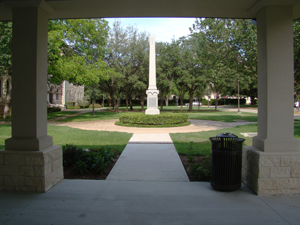
| |
|
| Progressive Traditions in the WCAC |
Design, Photography, and Text by Michael Morgan 2009
Email questions or comments to antoniopeter@gmail.com
Works Cited
Progressive Traditions in the WCAC: Home | Introduction | Pirate Bikes | Green Discourse | Progressive Traditions